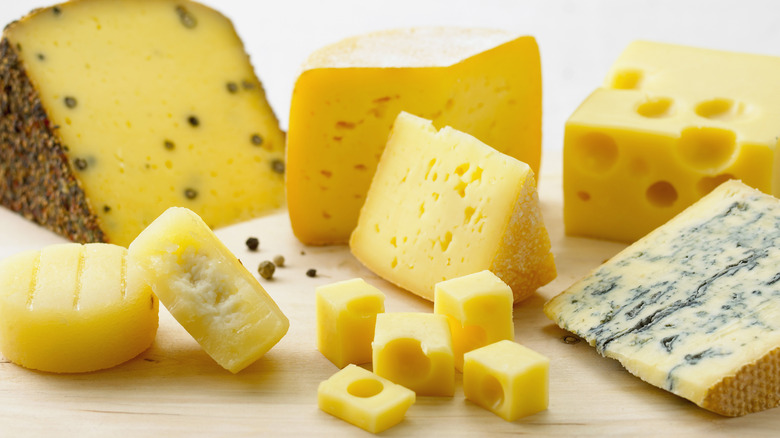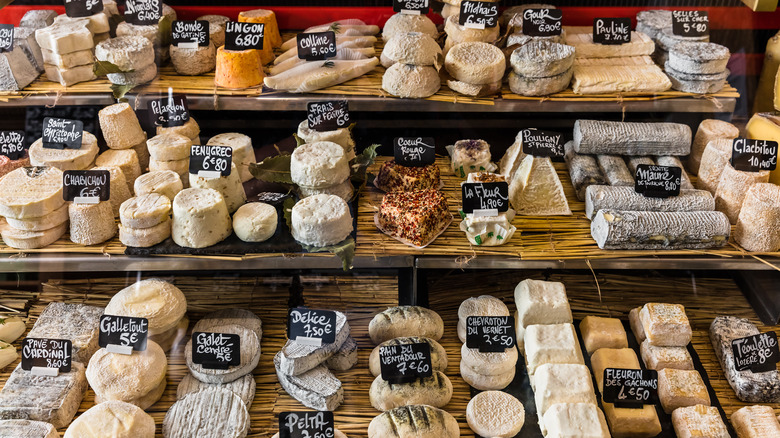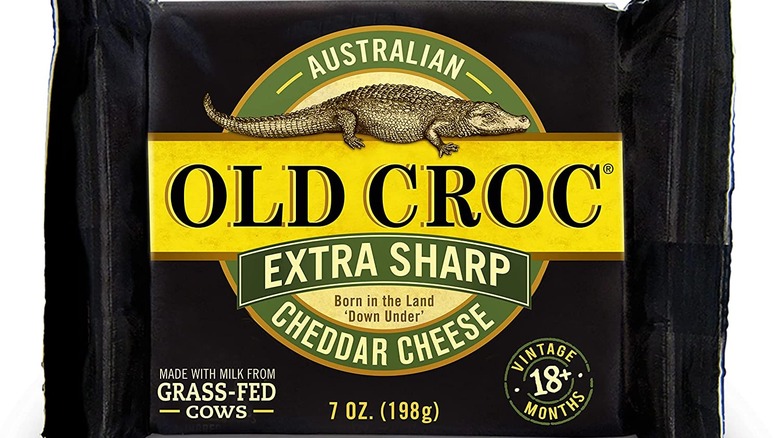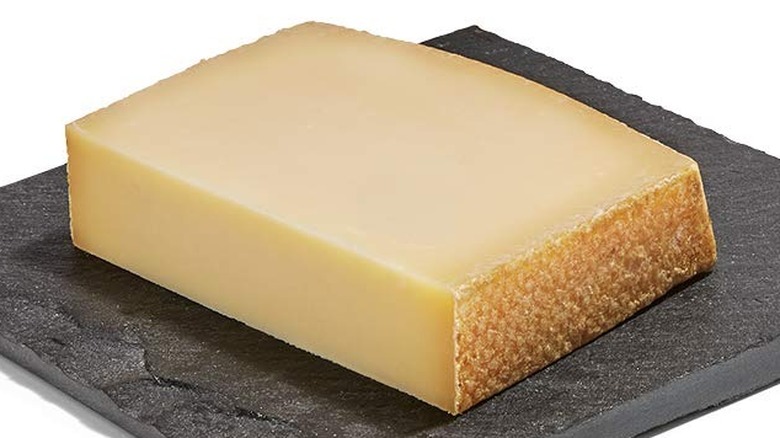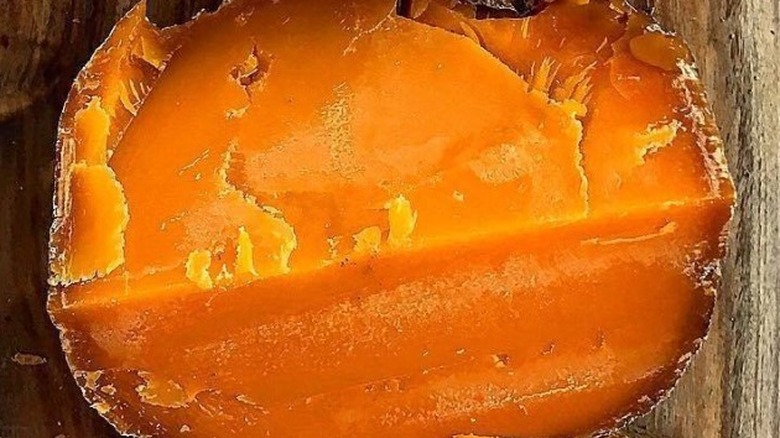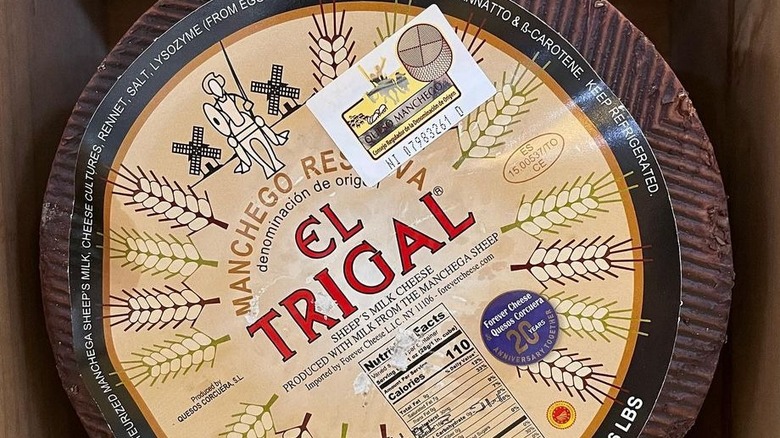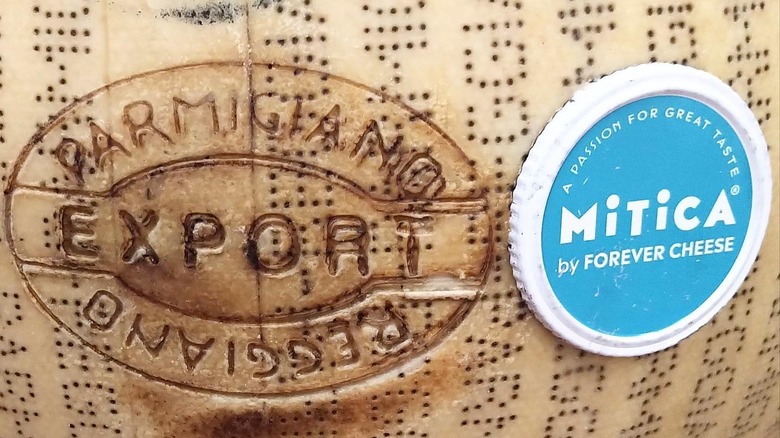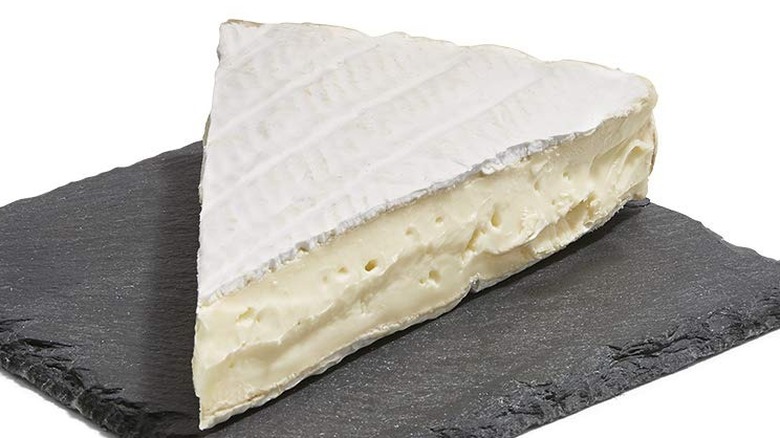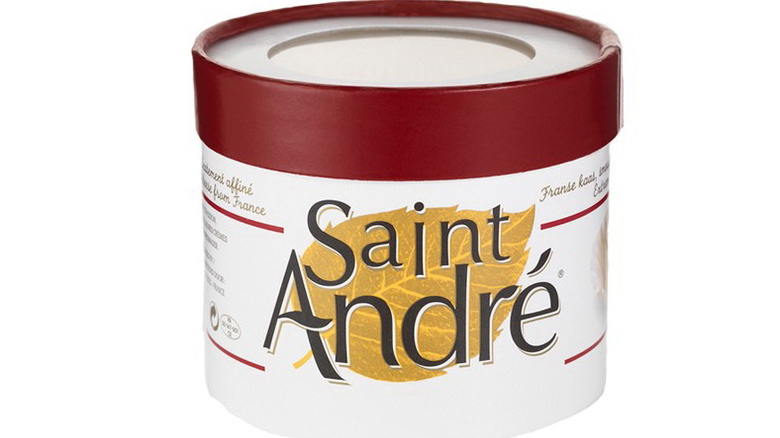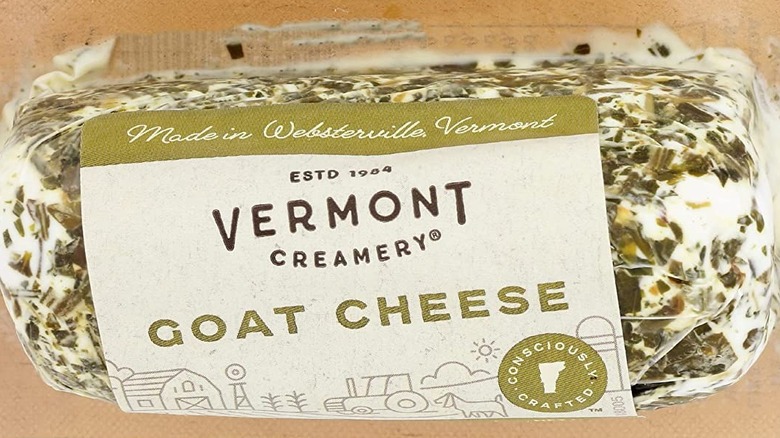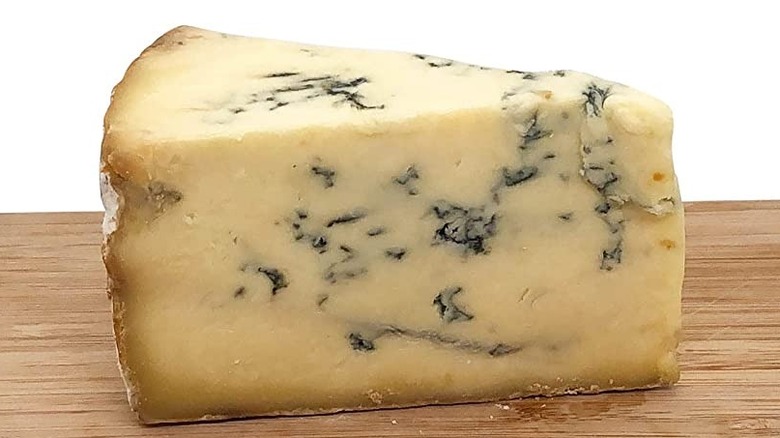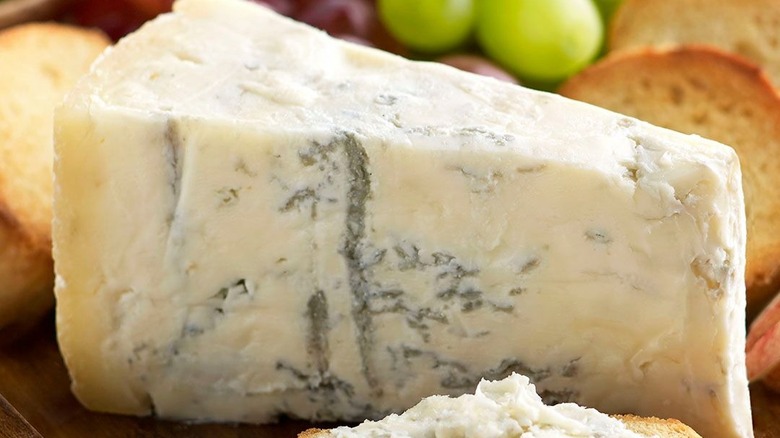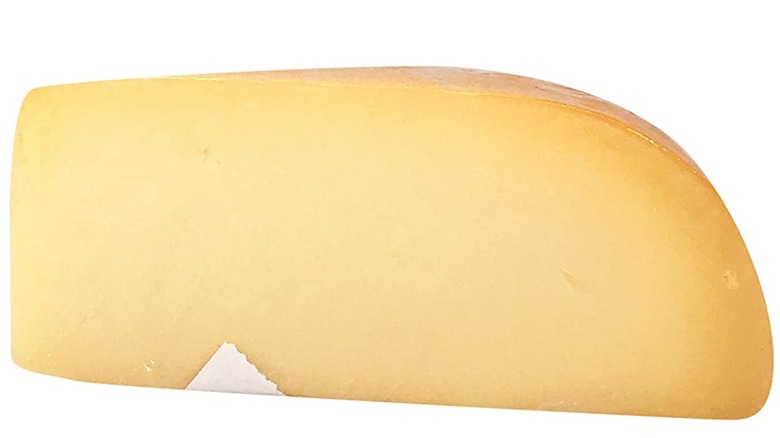The Best Cheeses For A Cheese Board
Sales in the United States of naturally produced cheese (meaning, no artificial additives) nearly hit $12.1 billion in 2021 while the nation ranked as the second largest producer of cheese in the world (per Statistica). So it's pretty safe to say that we love cheese. When paired with a glass of wine or port, cheese is one of the few edibles that's perfect as an appetizer or a dessert. One of the most popular ways of serving cheese is arranging a cheese board, but you may have wondered what is the best cheese to serve other than cheddar, gouda or brie, which, by the way, are all great choices.
Wisconsin is famous for being a state of obsessive cheese lovers, and according to Wisconsin Cheese, a cheese board should be composed of four to six cheeses of different textures. Good Housekeeping recommends three to five, but it's really up to you, based on the size of the board you're using and whether you're also serving condiments, like fruit, preserves, and nuts. As to the types of cheese, it's recommended that a cheese board should have a hard cheese, a semi-firm cheese, a soft creamy cheese, and, if it's to your taste, a blue cheese.
How we selected products
With so many cheeses available in the U.S. and abroad, it can be a real head-scratcher figuring out which cheeses to select for your cheese board. A majority of cheeses in Europe are made with raw cow's milk and are only found in their country of origin. We've sampled a good number of cheeses in France and Italy, and there really is a taste difference between a raw-milk cheese and a pasteurized-milk cheese. Unfortunately, the U.S. Food and Drug Administration has very strict regulations about raw-milk cheese, and importation of most types is banned (per Real Raw Milk Facts website). Consequently, we had to limit our search for this list to domestic or international cheeses made from pasteurized milk.
But that said, there is a glorious cornucopia of FDA-approved cheeses to choose from. We researched opinions by cheese experts and reviewers of the cheeses that are made in the traditional style but with pasteurized milk. If you shop for cheese at a local cheese shop, then you know cheese can be outrageously priced, so in our research we were mindful about finding delicious cheeses that won't wreak havoc on your food budget. Many of the cheeses we selected are pricey when bought by the pound, but you won't be needing a large hunk of it for a cheese board, just enough for a few slices per guest.
Best cheddar
No cheese board would be complete without a chunk of cheddar, arguably the most famous cheese in the world. Cheddar hails from Somerset, England, and gets its name from the market town, Cheddar, where the cheeses were first made and matured in the caves of the Cheddar Gorge (via The Courtyard Dairy). Although there is some evidence that cheddar cheese dates as far back as the 12th century, the cheddar that we know and love today originated in the 1800s. The cheddaring process involves stacking blocks of cheese curds on top of each other, which squeezes out moisture and allows for acidification. That is what creates the unique texture of the cheese. Depending on where the cheese is made, annatto (a flavorless, naturally occurring orange-red additive) is added to the curds to give cheddar its distinctive color.
The longer the cheddar matures, the sharper the flavor. Old Croc Extra Sharp is an Australian cheddar, made from non-GMO milk from grass-fed cows that has been aged for over 18 months. It's a white Cheddar (Old Croc doesn't add annatto) with a crumbly consistency when sliced, which makes it great for a cheese board since you want chunks and not a slab of it when tasting various cheeses. As expected, the flavor has quite a tang to it but also a note of sweetness. Old Croc is a favorite among Reddit cheese-lovers, who claim it's on par with other more expensive cheddars.
Best Gruyère
When you're considering what to put on your cheese board, set aside thoughts of a traditional Swiss cheese, and look into another type called Gruyère. According to the official Gruyère website, this hard, raw-milk cheese originated in the early 12th century in the small region of Fribourg, Switzerland. Production of traditional Gruyère is monitored under strict regulations as it's been granted the status as an AOP (which translates to "protected designation of origin"). Packages of Emmi Le Gruyère are commonly found in supermarkets, but Emmi is particularly well-known for its cheeses that are aged in the Kaltbach Cave, a subterranean sandstone cave in a mountain outside of Lucerne (per Travel + Leisure).
The cave's temperate 50 degrees Fahrenheit and 96% humidity keep the climate and mineral levels consistent and allow Gruyère to develop its unique aroma, flavor and rind color. Emmi ages about 150,000 wheels of cheese for at least nine months, all lovingly cared for by cave masters. The Emmi Kaltbach Cave-Aged Gruyère is a bit on the pricey side, but a small piece won't set you back too much, and it will be a distinctive addition to a cheese board. Even Gruyère lovers admit the Emmi Kaltbach has "funkyness," but its depth of flavor and nuttiness make it a classy "culinary pleasure."
Best French hard cheese
Another unusual and aesthetically pleasing addition to your cheese board would be the Isigny Ste Mère Mimolette. Mimolette is a hard French cheese with a neon-orange hue and pitted rind that, when whole, resembles a cantaloupe. According to Academy of Cheese, it was created in Flanders in the 17th century when Holland and France were at war, and the Dutch refused to export their beloved Edam cheese. In response, the French made their own version and dyed it bright orange with annatto to distinguish it from Dutch Edam. Mimolette's aging process also caused controversy in 2013 when the Food and Drug Administration banned it from the U.S. because shipments were apparently crawling with cheese mites, which are necessary to create the distinct cheese (per Washington Post). The ban was lifted a year later when it was determined that the harmless "bugs" were necessary for the cheese's natural maturation.
Per French food expert David Lebovitz, who toured Isigny Ste Mèere, once the Mimolette is formed, it's aged six to 24 months, during which time its outer crust develops with the help of the cheese mites. Isigny Ste Mère Mimolette is readily available in the U.S. and is usually sold pre-cut into slices, which is a good thing, since a whole, fully aged cheese can be a challenge to cut with a knife. Its taste, according to one Redditor, is nutty and similar to aged Gouda.
Best manchego
Manchego cheese is produced in Spain's La Mancha region (of Don Quixote fame) and is exclusively made from manchega sheep's milk. According to Cheese.com, commercially produced manchego is made from pasteurized milk, while farmhouse or artisan manchego is made from raw milk. The Corcuera family is a leader in the Manchego-cheese business and produces three brands of manchego, with El Trigal among them. El Trigal Manchego is more readily available in the U.S. than Corcuera's other brands and is sold at various months of aging. Younger manchegos range in color from pale white to ivory to cream-toned and can be fruity- or nutty-tasting.
The more mature manchegos, like El Trigal 12-Month Manchego, have a peppery bite with herbal overtones. Manchego has a distinctive herringbone-patterned wax rind that is inedible. Whereas young manchegos are soft or semi-firm, an aged manchego is a firm cheese that can be cut into chunks and enjoyed with fruit and wine. One fan of the El Trigal 12-Month says it's "highly addictive" and almost impossible not to eat the whole cheese "in one sitting." Manchego shows up on many cheese boards as an alternative to cheddar or Parmesan.
Best Parmigiano-Reggiano
Dubbed the "King of Cheeses," Parmigiano-Reggiano is Italy's most famous export. According to Wine Enthusiast, Parmigiano has been used as an aphrodisiac, loan collateral, ice cream flavor, and baby-weaning food. Parmigiano-Reggiano has protected status, and its manufacture is strictly regulated by a consortium to ensure that each 90-pound wheel is authentic. All Parmigiano-Reggiano is aged for one year, after which it's tested by the consortium to determine whether it's deemed worthy enough for the official stamp. If so, it can then be sold or aged six to 12 months longer.
Mitica 24-month Parmigiano-Reggiano has thousands of fans who rave about the cheese's authentic taste and texture. Mitica is the trademarked brand of Forever Cheese, a renowned food importer based in the Astoria neighborhood in Queens, New York. Forever Cheese sources Parmigiano-Reggiano from meticulously curated farms in the Emilia-Romagna region of Italy. All Mitica's Parmigiano-Reggiano is aged 24 months, which gives the cheese a crumbly texture and a grainy feel on the tongue. This long aging process also affects the cheese's flavor with a balance of sweetness and saltiness. Surprisingly, for such a superb cheese, Mitica Parmigiano-Reggiano is less expensive than some of its competitors.
Best brie
We feel confident stating that millions of cheese boards have included a wedge of brie, and unless you've personally flown it in from France, the brie we get here isn't what the French call brie. In France, brie is made with unpasteurized milk, and all its beneficial bacteria imbue authentic brie with its heady (some might say "stinky") fragrance and earthy flavor (via The New York Times). Pasteurization is a fighting word for French brie traditionalists, and we've sampled many a raw-milk cheese, and there's definitely something to be said about how delicious the bacteria makes it. But not all bacteria is healthy, and Lactalis — the world's second largest producer of dairy products — came up with a way to gently pasteurize the milk so the bad bacteria is killed. In so doing, Lactalis had to abandon its AOC status.
But fans agree that Lactalis Brie de Paris is a prime example of how good a French pasteurized brie can taste. According to The New York Times, brie should be redolent of mushrooms and wine and should be soft and pliable when ripened properly. Also worth noting is that a sliced wedge of brie will not ripen, so either purchase an entire round or make sure it's ripe when you buy it. Brie de Paris seems to hit all the right notes with its artisanal mushroom flavor and buttery consistency, per reviewers on Amazon.
Best triple crème
Saint André Triple Crème looks like a brie, but at 75% butterfat, it's much creamier. Coutances, France, where Saint Andre is made, is blessed with a temperate climate and frequent rainfall, which allows the manufacturer's cows to graze all year long, resulting in very rich and tasty milk and cream. Triple crème cheeses are required by law to have 75% butterfat, and so Saint André infuses the grass-fed milk with full-fat cream to bring it up to code (per New England Cheesemaking Supply Company). Saint André has a short ripening period during which time the white and velvety (and completely edible) rind blooms.
As you might expect, Saint André is decadently rich with a consistency of softened butter. Technically, Saint André is not a brie, but it does taste like brie, only more intense. This is a luscious cheese that spreads easily on crackers or bread (as one enthusiastic Redditor posted) and is sold by the slice. As with brie, a slice of Saint André won't ripen, but you can purchase a mini, whole Saint André that will ripen when brought to room temperature, and its small size fits snugly and neatly on a cheese board.
Best goat cheese
Goat cheese is another popular option that shows up on many a cheese board. Despite the many health benefits of goat's milk, especially for people who are lactose intolerant (per Healthline), it's not always to everyone's taste, since goat's milk cheese can sometimes be pretty "goaty." According to Cheese Science Toolkit, the reason for the barnyard flavor is that goat's milk has totally different fatty acids than cow's milk, and these fats, together, create the distinctive scent and taste of goat's milk and goat's milk cheese. Other factors, like what the goat eats, freshness of the milk, and proper handling, are also key factors in goat cheese's tang and flavor (via Cultures For Health).
Vermont Creamery is an ecologically and socially minded business that produces delicious goat's milk and cheese. Its core belief is that taking conscientious and responsible care of the soil, flora, and fauna yields a better-tasting product. Perhaps the best representation of the Vermont Creamery's mission statement is its Goat Cheese with Herbs. From its Instagram account, you can see many photos of this goat cheese log being hand-rolled in a verdant mound of fresh herbs. Described as creamy and great for a cheese board, it's also approved by some people who don't like goat cheese.
Best blue cheese
Blue cheese is definitely a love-hate thing. We've sampled blue cheeses and have often found them to be dry and too sharp. But then there's a Colston Bassett Stilton, a buttery, sweet, creamy confection that should be on your cheese board. Colston Bassett Dairy has been in existence for over 100 years and still produces cheese from farms within a 1.5-mile radius. Only four cheesemakers since 1913 have supervised the proprietary recipe for Colston Bassett Stilton, one of whom works exclusively with Neal's Yard in Covent Garden, London. Neal's Yard imports Colston Bassett Stilton to the U.S. and can be found in cheese shops and specialty food markets.
Colston Bassett Stilton has won multiple awards and has even been deemed the best British cheese in the world (per Specialty Food Magazine). This wonderful mellow blue cheese has a creamy exterior with characteristic blue veins, but it doesn't have the sharp bite of other blue cheeses. One Redditor praises Colston Bassett Stilton as perfect for a cheese board, especially during the holiday season. Stilton does tend to dry out and get brittle after 12 weeks of being sliced, so do check the label to see when the Stilton you buy was packaged. If you fear blue cheeses, the Colston Bassett Stilton will melt those fears away as this cheese melts on your tongue.
Best Gorgonzola
Loved by Winston Churchill and served on the Titanic, Gorgonzola is the second-most famous cheese originating from Italy (via Web Food Culture). According to the Gorgonzola Consortium for the Protection of the Gorgonzola Cheese, tradition holds that this emblematic blue cheese was created in the town of Gorgonzola, outside Milan in 879 C.E. It was later more aptly called a stracchino verde for its distinctive green veins. There are two types of Gorgonzola: dolce and piccante. Dolce is soft and creamy with a sweet yet piquant taste and is aged 50 to 150 days, while piccante is aged 80 to 270 days and is crumbly and sharper in flavor.
In Italy, Gorgonzola is always a raw cow's milk cheese, but BelGioioso CreamyGorg — made in Wisconsin — is pasteurized and yet has won multiple awards, most recently first place in 2022 in the World Championship Cheese Contest (via FSR magazine). Many of Belgioiso's Italian cheese have also won awards, and although the CreamyGorg might not be 100% authentic, it's certainly a close approximation of a more expensive Italian import. The CreamyGorg is a dolce Gorgonzola (aged for 80 days) and has a spreadable consistency. It can be served on a cheese board with bread and fruit and is often enjoyed as an after-dinner course before dessert.
Best smoked cheese
Gouda is one of Holland's most famous cheeses that's been around since the 12th century, which makes it the one of the oldest cheeses that's still produced the same way today (via History of Cheese). Its name comes from the town of Gouda, where cheesemakers would gather to sell their wares. As with other countries who protect their beloved cheeses, Holland limits production to around 300 farmers who make Gouda in the traditional way. Artikaas has been making Gouda with the original recipe for about 200 years and has an array of Goudas, including its Youngsters Smoked Gouda.
It's true that a smoked cheese isn't essential to a cheese board, and many are flavored artificially or overly smoked. But a good smoked cheese will add a nice balance to richer, more pungent cheeses. The Artikaas smoked gouda is naturally cold smoked with hickory and involves infusing smoke around the cheese while keeping the heat that's causing the wood to smoke under 90 degrees Fahrenheit (per Fix Blog). The result is a toasty-flavored Gouda that isn't overpowered by the smoking process. Reviewers on Amazon praise the Artikaas smoked gouda as buttery and creamy and great for nibbling or topping a burger. Best of all, the Artikaas smoked gouda is reasonably priced and definitely worth trying.
